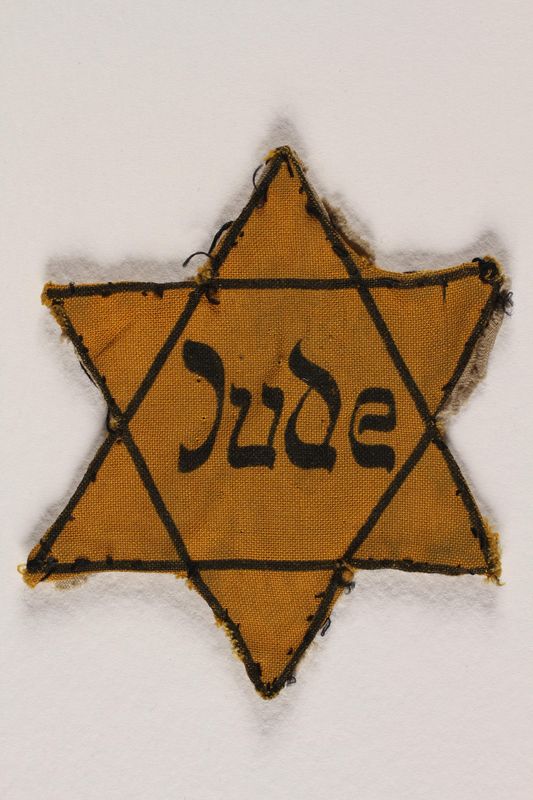Overview
- Brief Narrative
- Star of David yellow cloth badge with the German word, Jude, for Jew, worn in Lüneburg, Germany. In September 1941, the Nazi government ordered all Jews over the age of 6 to wear a badge with a Judenstern [Jewish star] on their outer clothing at all times to mark them as outcasts from German society and to make them easy to identify. In most places, the Jews were responsible for the manufacture and distribution of the badges. This type was printed on rolls of cloth with dotted cutting guidelines and cut off as needed. They were printed with dotted guidelines as aids for cutting one out neatly.
- Date
-
use:
after 1941 September-before 1945 May
- Geography
-
use:
Luneburg (Germany)
- Credit Line
- United States Holocaust Memorial Museum Collection
- Markings
- front, center, black dye : Jude [Jew]
Physical Details
- Language
- German
- Classification
-
Identifying Artifacts
- Category
-
Badges
- Object Type
-
Star of David badges (lcsh)
- Physical Description
- Yellow cloth badge in the shape of a 6 pointed Star of David handstitched with black thread to offwhite cloth backing. The star outline is formed from 2 overlapping, dyed triangles and has German text in the center. The frayed edges of the star are folded over and stitched with black thread; the edges of the backing are also folded over and stitched. There are pinholes on the front center and some loose threads.
- Dimensions
- overall: Height: 3.625 inches (9.208 cm) | Width: 3.125 inches (7.938 cm)
- Materials
- overall : cloth, dye
Rights & Restrictions
- Conditions on Access
- No restrictions on access
- Conditions on Use
- No restrictions on use
Keywords & Subjects
Administrative Notes
- Legal Status
- Permanent Collection
- Provenance
- The badge was acquired by the United States Holocaust Memorial Museum in 2004.
- Funding Note
- The cataloging of this artifact has been supported by a grant from the Conference on Jewish Material Claims Against Germany.
- Record last modified:
- 2022-09-12 08:59:24
- This page:
- https://collections.ushmm.org/search/catalog/irn517788
Download & Licensing
In-Person Research
- By Appointment
- Request 21 Days in Advance of Visit
- Plan a Research Visit
- Request to See This Object
Contact Us
Also in Luneberg, Germany, and Theresienstadt ghetto/labor camp documents and realia collection
The collection consists of artifacts, correspondence, documents, negatives, photographs, and publications relating to the history of the Holocaust in German occupied Czechoslovakia and Nazi Germany.
Date: approximately 1939-approximately 1945
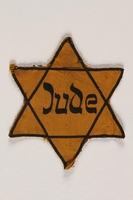
Star of David yellow cloth badge printed with Jude, the German word for Jew
Object
Star of David yellow cloth badge with the German word, Jude, for Jew, worn in Lüneburg (alternate spelling Lueneberg), Germany. In September 1941, the Nazi government ordered all Jews over the age of 6 to wear a badge with a Judenstern [Jewish star] on their outer clothing at all times to mark them as outcasts from German society and to make them easy to identify. In most places, the Jews were responsible for the manufacture and distribution of the badges. This type was printed on rolls of cloth with dotted cutting guidelines and cut off as needed. .
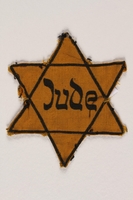
Star of David yellow cloth badge printed with Jude, the German word for Jew
Object
Star of David yellow cloth badge with the German word, Jude, for Jew, worn in Lüneburg (alternate spelling Lueneberg), Germany. In September 1941, the Nazi government ordered all Jews over the age of 6 to wear a badge with a Judenstern [Jewish star] on their outer clothing at all times to mark them as outcasts from German society and to make them easy to identify. In most places, the Jews were responsible for the manufacture and distribution of the badges. This type was printed on rolls of cloth with dotted cutting guidelines and cut off as needed.
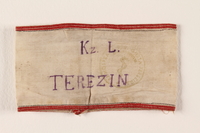
Handmade white armband stamped for medical personnel worn by an inmate in Theresienstadt
Object
Handmade white cloth armband presumably worn by an inmate at Theresienstadt ghetto/labor camp. It has a medical stamp and KZ. L Terezin handwritten on the center. The camp was run by the German SS but a Jewish Council of Elders organized municipal services, such as a health care system run by imprisoned doctors and nurses. Theresienstadt existed from November 24, 1941, until May 9, 1945, in the German controlled Protectorate of Bohemia and Moravia in the former Czechoslovakia. Terezin operated as a transit camp and and ghetto/labor camp for Jews deported from the Greater German Reich. It was expected that many would die due to the poor conditions. Approximately 140,000 Jews were transported to Terezin: 90,000 were deported to almost certain death in the east beginning in early 1942. Around 33,000 prisoners died in Theresienstadt. The International Red Cross took over administration of the camp on May 2, 1945. The German commandant and guards fled on May 5 and 6 as the Soviet Army neared the camp.
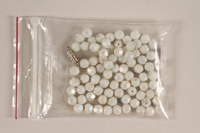
Opaque glass bead necklace found at Lüneburg
Object
Broken necklace found in Lüneburg, Germany, after the war. During the Nazi dictatorship, from October 1941 - spring 1945, the Lüneburg State Institute operated a special children's ward that participated in the euthanasia program to secretly kill mentally and physically disabled children. At least 300 children were murdered at Lüneburg by lethal overdose or starvation. The methods and implementation of the child-killing policy were left to each hospital. The policy was issued by the Office of the Fuhrer as part of the plan to create a master race and to cleanse the German population of genetically diseased persons.

Christmas gift box for Haeberlein-Metzger Nuremberg lebkuchen
Object
Haeberlein-Metzger Nuremberg lebkuchen packaging chest decorated with colorful images of gingerbread people, Christmas angels and ornaments. Lebkuchen is a biscuit similar to gingerbread cookies traditionally baked as a Christmas treat. It has been associated with Nuremberg since the 14th century and a variation known as Nuremberg Lebkuchen by law can only be produced in that city. The boxes and tins are often collected. This version was produced circa 1945 during the Nazi era in Germany.
Hinsel family papers
Document
The Hinsel family papers consist of biographical materials, correspondence, photographs, printed materials, and World War I diaries documenting the Hinsel family in Lüneburg, their relatives in Lüneburg and Hamburg, Hinsel and Leandrin family members’ military service during World War I, and Christine Hinsel’s survival in Theresienstadt during the Holocaust. Biographical materials include death announcements, ration cards, and business cards documenting Christine and Clemens Hinsel, their daughters, and other relatives. This series also includes a list of residents at Gertrud and Bruno Simon’s address listing Bruno Simon as air protection warden. Correspondence primarily consists of letters and postcards exchanged between Christine Hinsel and her relatives during World War II and during her imprisonment at Theresienstadt. This series also includes correspondence between Edeltraut Hinsel and Maria Leandrin, congratulatory notes on the birth and marriage of Maria Leandrin, and condolences on the death of Clemens and Christine Hinsel. A couple of letters date from Clemens Hinsel’s World War I service. Photographs depict Hinsel and Leandrin family members and friends before, during, and after World War II in Lüneburg, Hamburg, Adendorf, Celle, Osnabrück, Halle, and Essen-Borbeck-Mitte as well as relatives who immigrated to Seattle. This series also include photographs and photographic postcards documenting the World War I military service of members of the Leandrin family as well as photographs of a Leandrin family home in Lüneburg. Printed materials include early twentieth-century stock and bond certificates, a German cookbook, a meal-planning guide, booklets from the Wilhelm Raabe Schule in Lüneburg, clippings about the rights of children of mixed parents in Nazi Germany, an aerial target map of Hamburg, and a brochure about kibbutzim. Three diaries document Clemens Hinsel’s military service during World War I and include name lists, poems, notes, rations, movements, and descriptions of daily events.
Book
Object
Book
Object
Book
Object

